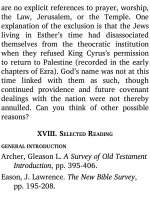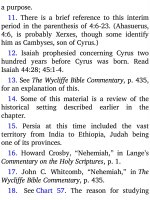Jensens survey of the old testament adam 99
Bạn đang xem bản rút gọn của tài liệu. Xem và tải ngay bản đầy đủ của tài liệu tại đây (118.1 KB, 4 trang )
(4:17-22): “And to Obed was born Jesse, and
to Jesse, David.” G. Campbell Morgan
comments, “In this nal word of the book
there is manifest the Divine moment in the
history of the chosen people. Thus the
kingly line was ordered in the midst of
in delity, through faithful souls.”2 God was
soon to allow Israel to have kings, and so, by
way of preparation, the book of Ruth
introduces the kingly line, Boaz and Ruth
being, the ancestors of King David, through
whom came the Saviour-King.
I. PREPARATION FOR STUDY
1. Read Matthew 1:1-17. Observe
especially the names given in verses 3-6.
Compare these with the names of Ruth 4:1822.
What
name
begins
Matthew’s
genealogy?3 Account for this, in view of the
fact that Matthew’s gospel was written
especially with the Jew in mind.
2. Consult an outside source on the
subject of typology.4 Determine the purpose
of Old Testament types, and how to
interpret them.
3. Refer to Chart 34. Observe on the chart
the suggested date for the marriage of Ruth
and Boaz.
4. Locate on a map the region of Moab
and the city of Bethlehem. This is the
geography of the book of Ruth.
II. BACKGROUND
A. TITLE
The book is named after its heroine, Ruth.
The name Ruth may be a Moabite
modi cation of the Hebrew reeiut, meaning
“friendship, association.”
B. DATE AND AUTHOR
The author is not known. The book may
have been written some time during the
reign of King David (1011-971 B.C.). It could
not have been written before then because
David’s name appears in 4:17,22. It may
have been written before the time of
Solomon, David’s successor on the throne,
since Solomon’s name is not included in the
genealogy of 4:18-22. It is very likely that
the author was a contemporary of David.
C. PLACE IN THE CANON
The book of Ruth follows Judges in our
canon, placed there to t the chronological
sequence. In the Hebrew Bible, it appears in
the third division (“Writings”) of the
threefold canon, under the group of ve
Megilloth books (Song of Solomon, Ruth,
Lamentations, Ecclesiastes, Esther). As noted
in earlier chapters, these books are read by
the Jews at annual feasts or holidays of the
Jewish calendar. The harvest eld setting of
Ruth makes it an appropriate liturgy for the
harvest festival (Pentecost).
III. SURVEY
1. First, read through the four chapters at
one time. If possible, read aloud. Familiarity
with the text is the rst law of Bible study.
Have pencil or pen in hand as you read so
you can make notations in your Bible along
the way.
2. Assign chapter titles, and record them
on paper.
3. Observe these items in the story:
people, places, actions, things. Record
outlines of these on paper.
4. Observe all the questions in the book.
Also, note the many references to “God” and
“LORD.”
5. Study the survey Chart 37. Compare its
outlines with the observations you have









